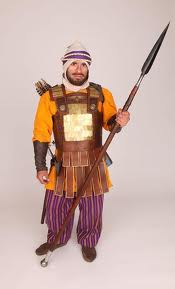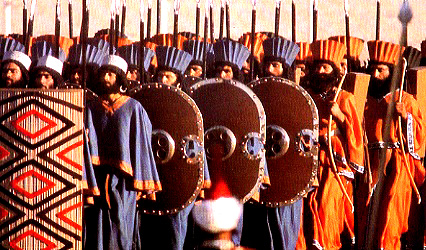Since Rome II has been released various modders have released mods that add units to the Persian factions and almoust every single one of them adds the "Immortals" as a unit.
But all of those show the immortals as they were depicted in the movie "300":
Example from Farsovereign Persian Empire mod:
http://www.twcenter.net/forums/showt...-for-Parthians
Spoiler Alert, click show to read:
Example from movie "300":
Spoiler Alert, click show to read:
Yet with 300 being a movie of sprayed on muscles, and weirdly designed arrowheads, and a "war rhinoceros" it seemed pritty obvious to me that the actualy Persian Immortals did not run arround with sliver masks, wore black cloaks and fought with double swords in slow motion.
So I took a half an hour to do a bit of half assed research (googling) into what they may have really looked like and what their functions were.
At first I thought that like the Roman Pretorian Guard the Immortals may have been nothing but an overgloryfied bunch who served the "gestapo function" in the ancient states.
Yet what I read so far suggested otherwise:
http://en.wikipedia.org/wiki/Immorta...sian_Empire%29The Immortals played an important role in Cyrus the Great's conquest of Babylon in 539 BC, Cambyses II's conquest of Egypt in 525 BC and Darius I's invasion of India's smaller western frontier kingdoms (western Punjab and Sindh, now in Pakistan) and Scythia in 520 BC and 513 BC. Immortals participated in the Battle of Thermopylae 480 BC[3] and were amongst the Persian occupation troops in Greece in 479 BC under Mardonius.
http://www.legendsandchronicles.com/...sian-warriors/The ancient Persian warriors were soldiers for the Persian Empire during the phases of its military life. The Immortals were the most renowned ancient Persian warriors, feared for their mass scale of attack and the fact that if you were to kill one Persian warrior another one would appear instantaneously giving the appearance of course, that they were indeed immortal.
It was during two phases of the Persian Empire, that the immortals were called upon to strike fear into their foes.
http://www.britannica.com/EBchecked/...sand-ImmortalsTen Thousand Immortals, in Persian history, core troops in the Achaemenian army, so named because their number of 10,000 was immediately reestablished after every loss. Under the direct leadership of the hazarapat, or commander in chief, the Immortals, who formed the king’s personal bodyguard, consisted primarily of Persians but also included Medes and Elamites. They apparently had special privileges, such as being allowed to take concubines and servants along with them on the march. On coloured glazed bricks and carved reliefs found at the Achaemenian capitals, such as the Palace of Artaxerxes at Susa, the Immortals are often represented standing stiffly at attention, each soldier’s wooden spear with its silver blade and pomegranate insignia held upright and resting firmly on his toe. They wore elaborate robes and much gold jewelry. An elite 1,000 of the Immortals were further distinguished by having gold pomegranates on their spears.
[TD="width: 21%"]
In his description of the battle of Thermopylae (480 BCE), the Greek researcher Herodotus mentions a Persian elite corps which he calls the Ten Thousand or the Athanatoi, the 'Immortals'. He describes them asa body of picked Persians under the leadership of Hydarnes, the son of Hydarnes. This corps was known as the Immortals, because it was invariably kept up to strength; if a man was killed or fell sick, the vacancy he left was at once filled, so that the total strength of the corps was never less -and never more- than ten thousand.As he indicates, Herodotus has already mentioned the Persian equipment:
Of all the troops in Persian army, the native Persians were not only the best but also the most magnificently equipped; their dress and armor I have mentioned already, but I should add that every man glittered with the gold which he carried about his person in unlimited quantity. They were accompanied, moreover, by covered carriages full of their women and servants, all elaborately fitted out. Special food, separate from that of the rest of the army, was brought along for them on dromedaries and mules. (Histories 7.83; tr. Aubrey de Selincourt)The dress of these troops consisted of the tiara, or soft felt cap, embroidered tunic with sleeves, a coat of mail looking like the scales of a fish, and trousers; for arms they carried light wicker shields, quivers slung below them, short spears, powerful bows with cane arrows, and short swords swinging from belts beside the right thigh. (Histories 7.61; tr. Aubrey de Selincourt)We also learn from Herodotus that this elite corps played an important during the Battle of Thermopylae. The Greeks had blocked a narrow road along the coast and prevented the Persians from invading Greece. However, the Immortals made a detour and were able to attack the Greeks in the rear. They are also mentioned during the second year of the war, in 479 BCE, when they remain in Greece in the army of the Persian commander Mardonius.
The big problem with this elite corps is that they are unknown from other sources. (There are, of course, other Greek and Latin texts that mention the Immortals, but they have taken this name for the Persian elite troops from Herodotus and simply mean: the royal guard.) There is ample evidence from Persia - e.g., the Persepolis fortification tablets - but it does not mention a corps of Immortals. Probably, Herodotus' informant has confused the name AnŻšiya ('companions') with Anauša ('Immortals').
The historians of Alexander the Great mention another elite regiment, which they call the Apple Bearers. Their spears had a small metal counterweight to balance the heavy point. Because this counterweight resembled an apple, they received their remarkable surname. Several scholars believe they are identical to the Immortals.
[/TD]
http://www.livius.org/ia-in/immortals/immortals.html
It also seems as if the Immoratls were not used as a military unit at the time that Rome II is set in. Butthat.
There is some information about their apperance in the sources mentioned above. And I also found this very informative:
http://monolith.dnsalias.org/~marsar.../p_immort.htmlHis clothes in this picture were used in combat, he wore completely different clothes when he acted as the bodyguard of the king. That type of clothing is more ceremonial and is normally seen on sculptures in Persepolis. The ceremonial clothing was of course more subtle, but less practical on the battlefield. One of the main weapons of an Immortal were the short bow which was of little use against the heavy armoured Greek hoplites. His other main weapon was quite a short spear with an iron point and a silver counterbalance (the officers had a golden counterbalance). A short sword, or a big dagger, completed the weaponry of an Immortal.
A corset with metal plates is worn under his tunic to offer some protection. Compared to the elite of the Greek forces was he hardly armoured. In his left hand he is holding the gerron: a traditional shield made of wicker and leather. This shield gave him enough protection against arrows, but it certainly could not stop a well aimed thrust of a spear of a Greek hoplite while the Greek hoplon could stop such an attack. On his head he is wearing the tiara: a soft cap made of fabric which he could pull down over his face when he marched through a desert. His loose tunic is richly decorated with embroidery and was often painted in purple, blue, yellow, or white.
In spite of his courage was even the Immortal inferior to a Greek hoplite on the battlefield. The obsolete shield, the lack of greaves and helmet, and the fact that his only advantage, the bow, was useless against the Greek armoured hoplites made the Immortals of less strong than the hoplite. He was a professional soldier just like the Spartans, but the Persian army did not use a tactic which could stop the phalanx. Nevertheless were the Immortals extremely important on the battlefield, and during the battle of Plataea they only retreated after their leader Mardonius was killed. A reason for his inferior equipment might have been his value within the Persian armies which mostly depended on huge amounts of cavalry and archers. Later on the Persian infantry started to use the Greek hoplon and short sword, but they still hardly used any armour most of the time.
Of course were there more types of infantry in the Persian army. Many vanquished people from many different places were forced to fight in the Persian warmachine, and that explains the diversity of the Persian army. Besides their inferior equipment was this also a big disadvantage while fighting the Greeks. The Persians did not form an unity, they did not fight in groups like a phalanx. On top of that fought they in a strange land. The Greeks knew the advantages and the disadvantages of the terrain, and they fought for their homeland... they had a much higher moral.
To know more about their apperance I actualy even took a quick look at that "TV show" Deadlies Warrior, which is the worst thing to be broadcasted on TV after Sons of Anarchy.
They had this picture representing what a soldier would have looked like:
the "deadliest warrior wiki" also offered some information to armor and weapons:
The Persian Immortals wore a corset of overlapping bronze scales underneath their robes (though in Deadliest Warrior the Immortal is shown wearing it outside of his robes). The show proved that the armor can protect the Immortal, but will break or fall apart if it recieves heavy damage. They carried a wicker shield known as a gerron, though they adopted the Greek aspis during the Greco-Persian Wars after realizing that it offered far greater protection against the Greeks' weapons.It also mentions a special unit on chariots.The Sagaris was a weapon similar to a War Hammer or a small battle-axe. It was the Close-Range weapon of the Persian Immortal.
http://deadliestwarrior.wikia.com/wiki/Persian_Immortal
Yet I dont eally take the information from this show that much serious since it is nothing but history channel style white trash entertainment crap.
Concerning a picture search, these are the pics I thought being worth showing:
Sassanian Persian Savaran Cataphract Armor:
Spoiler Alert, click show to read:
Achaemenian Elite Persian Immortal Heavy Armor
Spoiler Alert, click show to read:
Achaemenian Elite Persian Immortal
Spoiler Alert, click show to read:
Achaemenid Persian Immortal
Spoiler Alert, click show to read:
http://www.radpour.com/armor
This site also offers various picks and information yet I was slightly too lazy to post all those pics:
http://iranpoliticsclub.net/history/...ation-persia1/
This pic is from Wikipedia and shows actors dressed as immortals at the 2500 years aniversery celebration of the Persian empire (the last Iranian Shah loved to mystify and theatricaly show himself with ancient Persian stuff)
In conclusion, nothing really shows that the image of the black dressed trooper from the 300 movie is in any way correct.
What I did read was non the less really interesting.
Basic soldiers wearing blue clothes and gold and armed with axes and/or spears.
A unit on chariots wearing blue clothes.
An elite unite with pikes that have silver "apples" as a counterweight wearing blue clothes.
An elite unit with spears that have silver spearheads wearing golden clothes.
And elite troop guarding royalty with even more lavish golden clothes and spears that have golden spearheads.
Apparently, basic immortal troops wore blue and the elites wore golden clothes, yet other information states that what the immortals wore in battle differenciates alot from what they wore during parades, on guard or other.
I hope this was informative and that despite my half assed research this has been an interesting read for you, maybe you may aswell have something to add.
It would be great if someone would use this information to create a unit pack.
I also want to make it very clear, that I am not trying to in anyway critizise unit packs which show the immortals in the style of the 300 movie.














 Reply With Quote
Reply With Quote














